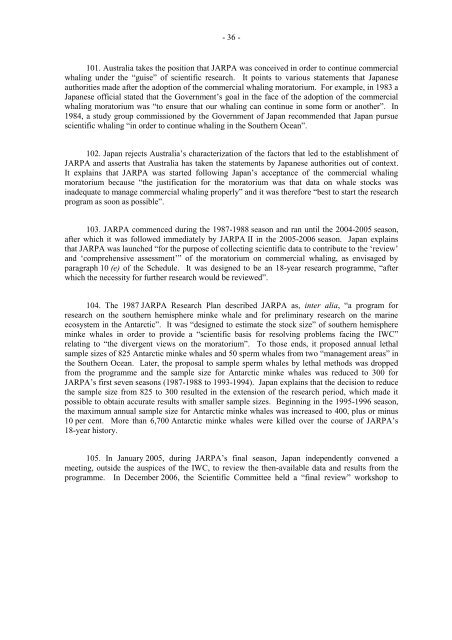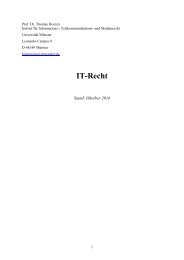3d4yVkKMl
3d4yVkKMl
3d4yVkKMl
You also want an ePaper? Increase the reach of your titles
YUMPU automatically turns print PDFs into web optimized ePapers that Google loves.
- 36 -<br />
101. Australia takes the position that JARPA was conceived in order to continue commercial<br />
whaling under the “guise” of scientific research. It points to various statements that Japanese<br />
authorities made after the adoption of the commercial whaling moratorium. For example, in 1983 a<br />
Japanese official stated that the Government’s goal in the face of the adoption of the commercial<br />
whaling moratorium was “to ensure that our whaling can continue in some form or another”. In<br />
1984, a study group commissioned by the Government of Japan recommended that Japan pursue<br />
scientific whaling “in order to continue whaling in the Southern Ocean”.<br />
102. Japan rejects Australia’s characterization of the factors that led to the establishment of<br />
JARPA and asserts that Australia has taken the statements by Japanese authorities out of context.<br />
It explains that JARPA was started following Japan’s acceptance of the commercial whaling<br />
moratorium because “the justification for the moratorium was that data on whale stocks was<br />
inadequate to manage commercial whaling properly” and it was therefore “best to start the research<br />
program as soon as possible”.<br />
103. JARPA commenced during the 1987-1988 season and ran until the 2004-2005 season,<br />
after which it was followed immediately by JARPA II in the 2005-2006 season. Japan explains<br />
that JARPA was launched “for the purpose of collecting scientific data to contribute to the ‘review’<br />
and ‘comprehensive assessment’” of the moratorium on commercial whaling, as envisaged by<br />
paragraph 10 (e) of the Schedule. It was designed to be an 18-year research programme, “after<br />
which the necessity for further research would be reviewed”.<br />
104. The 1987 JARPA Research Plan described JARPA as, inter alia, “a program for<br />
research on the southern hemisphere minke whale and for preliminary research on the marine<br />
ecosystem in the Antarctic”. It was “designed to estimate the stock size” of southern hemisphere<br />
minke whales in order to provide a “scientific basis for resolving problems facing the IWC”<br />
relating to “the divergent views on the moratorium”. To those ends, it proposed annual lethal<br />
sample sizes of 825 Antarctic minke whales and 50 sperm whales from two “management areas” in<br />
the Southern Ocean. Later, the proposal to sample sperm whales by lethal methods was dropped<br />
from the programme and the sample size for Antarctic minke whales was reduced to 300 for<br />
JARPA’s first seven seasons (1987-1988 to 1993-1994). Japan explains that the decision to reduce<br />
the sample size from 825 to 300 resulted in the extension of the research period, which made it<br />
possible to obtain accurate results with smaller sample sizes. Beginning in the 1995-1996 season,<br />
the maximum annual sample size for Antarctic minke whales was increased to 400, plus or minus<br />
10 per cent. More than 6,700 Antarctic minke whales were killed over the course of JARPA’s<br />
18-year history.<br />
105. In January 2005, during JARPA’s final season, Japan independently convened a<br />
meeting, outside the auspices of the IWC, to review the then-available data and results from the<br />
programme. In December 2006, the Scientific Committee held a “final review” workshop to



